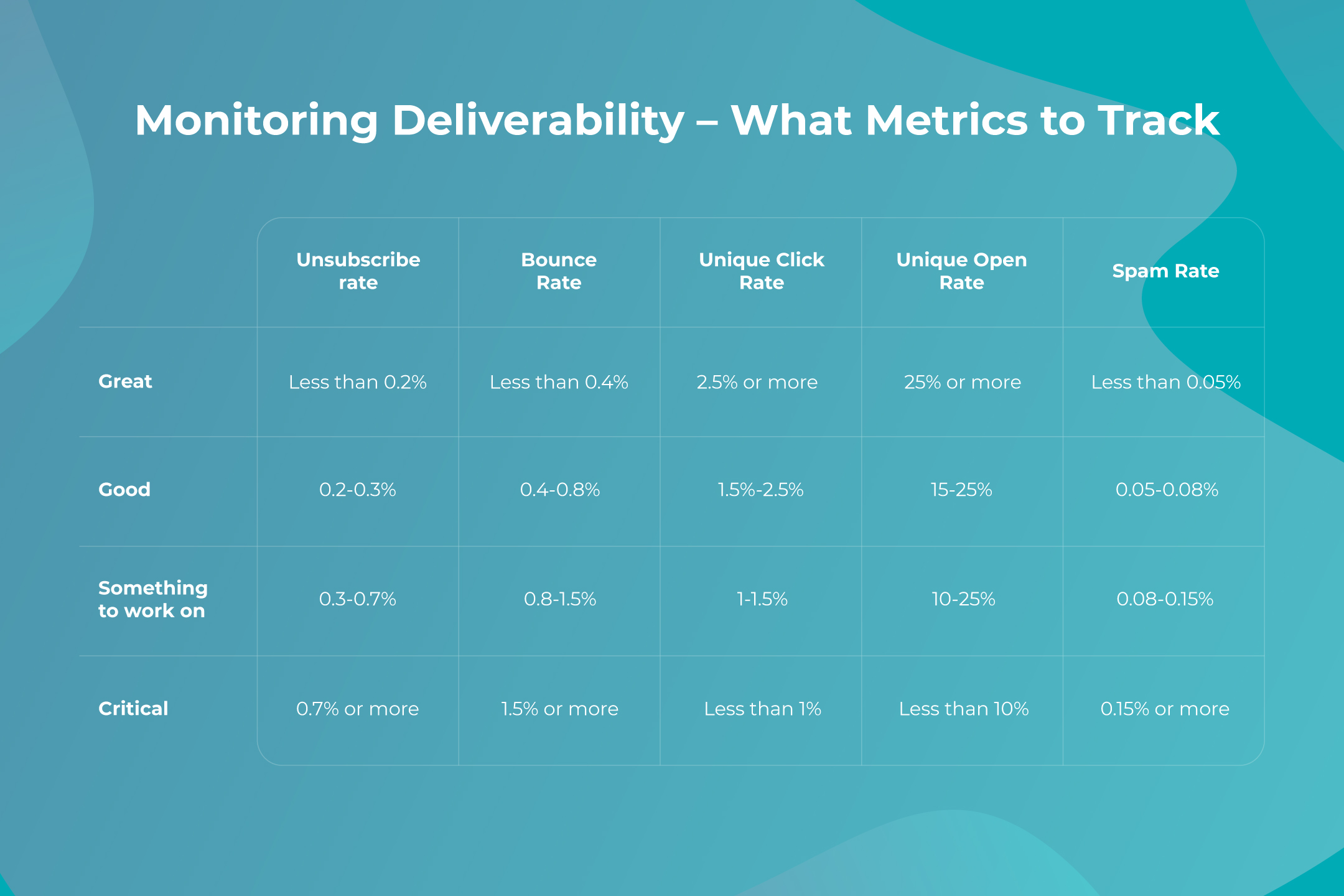 “I don’t need to worry about deliverability because I don’t buy email lists; I acquire subscribers through carefully tailored acquisition strategies.”
“I don’t need to worry about deliverability because I don’t buy email lists; I acquire subscribers through carefully tailored acquisition strategies.”
“I’ll never have any deliverability issues because I email my subscribers infrequently and only when I have something important to say.”
“I don’t need to know about deliverability; I’m a small brand with a small database.”
Have any of these thoughts ever crossed your mind? If so, you definitely need to know more about deliverability to ensure that your emails land in your subscribers’ inboxes.
When researching deliverability, you’re likely to find many detailed tips on how to ‘win’ the spam filters and outsmart them. Remember that people having these conversations have a reason to try and outsmart the inbox algorithms. It often means their content is probably of not that much value, and their activity is aiming at puffing up their email marketing KPIs in a short-sighted way.
This is the reason why many purpose-driven brands don’t even get interested in the subject. They believe that since their messages are genuine and they don’t email “too often,” their subscribers will be engaging with their emails naturally. While authentic, valuable, and interesting content is very important to keep your audience engaged, that alone will not protect your brand from being flagged by inbox providers if you don’t follow their rules. Let’s see how purpose-driven brands can manage their deliverability and make it a good one.
So What is Deliverability Exactly?
It’s one of those annoying terms in marketing that has a million and one definitions, and neither really makes a lot of sense when you read it for the first time. To me, the best one I’ve heard sounds like this:
Deliverability is a sum of various factors determining if your email messages reach and resonate with your subscribers.
These factors are:
- The ability of your messages to reach your subscribers’ inboxes
- The relevance of the content you’re sharing
- Structure and content of the message itself
- The performance of the messages
- Your sender reputation
The tricky bit about deliverability is that it isn’t a number you can track, so trying to understand how your brand is doing will sometimes feel a little like ghost-hunting. The way to get a feel for how you’re doing is to monitor your basic email KPIs regularly and consider them in the context of what they might tell you about your deliverability.
The KPIs strongly recommended to keep an eye on are:
- Open Rate
- Click Rate
- Bounce Rate
- Unsubscribe Rate
- Spam Rate
The best way forward is to understand what these metrics look like in your sector and how close your results are to them. The inbox providers, such as Gmail, Yahoo, and Outlook, constantly scan the messages that are being sent to the users of their inboxes and assess them to categorize them. The algorithms on the inbox providers’ side aim to provide a good experience for their customers by filtering out harmful and irrelevant emails. They do it by moving them into spam, refusing receipt, which causes the email to bounce, and eventually blacklisting a sender, which will block any future communication coming from that domain. Understanding benchmarks for your sector’s KPIs will help you understand how you’re doing compared to your peers and determine if you might be getting in trouble with your deliverability.
It’s good to consider iOS15 in the context of evaluating your key metrics. If your brand’s database consists of a significant share of iOS users, your metrics might start getting affected by the privacy practices introduced with the iOS15 release. The bottom line is that iOS users will be reporting artificially inflated Open Rates caused by their devices “opening” the emails without the user actually doing anything. In this case, it’s important to bear this in mind and watch your Click Rates even more closely. If the increase in your Open Rates isn’t followed by a boost in your Click Rates, it might not be a result of your genius subject line tactics – it might be a sign that your database is starting to get affected by iOS15.
See what metrics to track when you want a good overview of your deliverability:
What to do to Maintain Good Deliverability in Your Email Marketing?
Since deliverability is best monitored by keeping an eye on the key email marketing metrics, what you need to do to keep in the good books of all inbox providers, is to apply best practice email tactics. Here are our top 7 tips that will help you ensure your email messages make it through to your subscribers’ inboxes and are relevant to them.
- Introduce a double opt-in. This will help keep your data clean and prevent those much-dreaded email bounces.
- Segment your audience – always! As the old saying goes – if you speak to everyone, nobody listens. In order to meet your audience’s expectations regarding content, frequency of communication, and, most importantly, their current stage of the customer journey, we repeat: segment your audience. Always. Amen.
- Have a clear CTA. This one isn’t just about having a big, fat button in the middle of the body of the message, it’s about having a clear intention as to why you decided to contact your customers. A framework we like to recommend to our clients is the following – whenever you email, make sure the following is super clear to your audience:
- Why are you emailing me?
- What do you want me to do?
- Why should I care?
- Automate for consistent customer experience. Identify those elements of your communications that you feel are important for every subscriber to know but that you don’t want to keep repeating in your BAU (business as usual) campaigns. A good example is the story behind your brand and how did the company start. This sort of content lends itself well to being part of the welcome automation, as you’d want everyone to be exposed to it at the beginning of their journey with your brand.
- Personalize your messages. Show your customers you know them – include references of what they purchased before or how they interacted with you to create a sense of continuous conversation and not just blasting the same message to everyone.
- Easy access to the unsubscribe link. And we mean it – no funny business here, please! It’s not only a bad customer experience not to be able to find an unsubscribe link when a customer feels they want to move on, it’s also something that the algorithms on the side of inbox providers have their radars tuned in to. Seriously, let them go. It’s not worth it.
- Clean your list regularly! Best to do a good spring clean every 4-6 months and remove contacts that have stopped interacting with your messages a while back. No matter what you do, they’re very unlikely to buy again, so in order to protect your sender’s reputation and deliverability, it’s best to remove them from your ESP.

What to do When You’re in Trouble
If you are reading this article and you are actually already in trouble with your deliverability and email service providers, let’s review what to do in this situation.
- Limit sending and concentrate on the most engaged users. This can be difficult to do as it means you are not sending to your entire email list. But it actually helps you rebuild your sender reputation, as you will email more to those who really engage with your emails. So identify those most engaged and start sending emails to segments truly interested in your content.
- Consider segmenting by Inbox Service Provider. This lets you understand how people interact with your emails across different service providers. Segmenting them like this and looking at the numbers can help you identify where the problem lies.
- Gradually warm up segments that you’ve seen the most problems with. Once you understand where the problem may lie, you can go on a journey of gradually warming up those segments with content targeted towards them.
- Be patient – it takes time to rebuild your sender’s reputation. Be sure to be patient with this process, as it takes time and will not happen over a week or two. Just as it takes time to damage your deliverability, it takes even longer to rebuild it.
- Focus on providing value to those who engage and respond. Stay positive throughout the process. A negative attitude and focus only on the deliverability problem damages relationships with other customers who are engaged and loyal. Therefore, continue to maintain relationships with those who communicate with you to avoid the relationship cooling and losing them.
In some cases, we may also take steps that we hope will help, which actually do us a disservice and worsen the situation. We’ll point out some steps that must be avoided while improving deliverability.
What to avoid:
- Increase email frequency to compensate for low open rates. If your deliverability has already suffered and you start sending even more emails, you’re going to get yourself into more of a mess. So, address the root causes before you start sending the same content with the same mistakes more often.
- Drive open rates at any cost. Some companies use very shady tactics, such as “Richard Branson almost stopped this email!” subject lines. Obviously, these claims are untrue, and your customers will understand immediately. So they won’t open your emails again, let alone interact with them. Stick to your business purpose and focus on truly helping your customers with your services and the information you share instead of just focusing on the numbers.
- Buy ‘qualified and engaged’ lists to compensate for low metrics. As much as there are some B2C lists out there (although they are also not recommended), D2C lists, for example, are practically non-existent. If you buy lists, you will be in more trouble with your deliverability and reputation.
- Remove the unsubscribe link or make it tricky to find. This point is self-explanatory. The absence of an unsubscribe link is against GDPR and other rules. Make sure that it is also clearly visible – this way, uninterested subscribers can actually remove themselves from your mailing list, doing both themselves and you a favor.
Conclusion
While deliverability may appear like some mysterious concept, at the end of the day, it’s all about providing a good, personalized experience to your customers. If you commit to serving them as best as possible and building true relationships with them – you will never go wrong. Apply the best practice tips we listed above and do it with the integrity of your brand. Your customers will appreciate it, and the inbox providers will welcome your emails with their open (robot) arms.
About the Author

